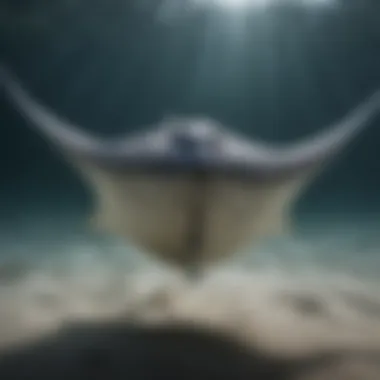Discover the Enchanting World of Stingrays: Fascinating Insights for Young Minds


Nature Topic Overview
Dive deep into the mesmerizing world of stingrays, those intriguing marine creatures that glide effortlessly through the oceans. These unique beings captivate young minds with their distinctive features and behaviors, offering a blend of education and entertainment for budding nature enthusiasts.
Fun Facts and Trivia
Stingrays come in various shapes and sizes, from the small freshwater species to the giants of the ocean. Did you know that stingrays are related to sharks and share similar characteristics, such as cartilage instead of bones? Their flat bodies allow them to blend seamlessly into the ocean floor, making them excellent ambush predators. Picture quizzes and interactive games can help children learn more about these fascinating creatures.
Wildlife Explorations
Explore different species of stingrays, such as the eagle ray or manta ray, each exhibiting unique traits and behaviors. Dive into their habitats, from coral reefs to sandy seabeds, and discover the diverse marine life that coexists with stingrays. Interactive features like quizzes and puzzles can engage young minds in discovering more about the intriguing world of stingrays.
Environmental Awareness
Stingrays play a vital role in marine ecosystems, and it's crucial to emphasize the importance of conservation and sustainability. Children can learn simple ways to contribute to protecting nature, such as avoiding littering on beaches or participating in local beach clean-up activities. By instilling a sense of responsibility towards the environment at a young age, kids can grow up to be mindful stewards of our planet.
DIY Nature Activities
Encourage kids to immerse themselves in nature through hands-on activities and experiments related to stingrays. Create crafts like paper stingrays or embark on outdoor explorations to observe marine life in its natural habitat. Step-by-step guides can assist children in understanding the anatomy and behavior of stingrays while fostering a sense of curiosity and wonder for the natural world.
Introduction to Stingrays
Stingrays, enigmatic creatures of the ocean, hold a mystique that captivates both young and old. In this article, we embark on an exciting journey to unravel the secrets of these magnificent sea-dwellers. By exploring the unique traits, behaviors, and significance of stingrays, we aim to provide a comprehensive guide that enlightens and entertains young minds eager to delve into the marine world.
What are Stingrays?


Stingrays, also known as pancake fish, are a fascinating group of flattened cartilaginous fish that glide gracefully through the seas. Their distinctive features include broad, flat bodies resembling discs, with mesmerizing wing-like fins that propel them effortlessly. One of the most iconic features of stingrays is their elongated tails, often adorned with a venomous sting that serves as a defense mechanism against predators. These serene creatures can vary in size, with some species spanning up to several feet in width, adding to their allure and intrigue.
Evolutionary History of Stingrays
The evolutionary history of stingrays dates back millions of years, showcasing their remarkable adaptation to marine environments. These ancient beings have evolved unique anatomical structures that equip them for survival in the depths of the ocean. Through millennia of refinement, stingrays have perfected their streamlined bodies and sensory adaptations, enabling them to navigate the waters with unparalleled grace and efficiency.
Types of Stingrays
Within the vast expanse of the marine world, stingrays exhibit a diverse array of species, each holding its own allure and characteristics. From the majestic manta rays to the elusive electric rays, the realm of stingrays offers a rich tapestry of biodiversity waiting to be explored. By delving into the intricacies of these different species, we gain a deeper appreciation for the complexity and beauty of marine life.
Different species of stingrays
Among the myriad species of stingrays, each harbors unique attributes that contribute to the rich tapestry of marine diversity. From the elegant blue spotted stingrays to the robust Southern stingrays, each species boasts distinct physical features and behaviors that set them apart. By examining the nuanced differences among these species, we unveil the sheer diversity and splendor of the stingray family tree, enriching our understanding of the vast underwater ecosystem.
Physical Characteristics
Stingrays possess distinctive physical characteristics essential for their survival in diverse aquatic environments. These features play a crucial role in their ability to navigate and thrive in water bodies. The flat bodies of stingrays, combined with their wing-like fins, enable them to effortlessly glide through the water with precision and speed. These adaptations provide stingrays with excellent maneuverability, allowing them to swiftly evade predators and capture prey. Additionally, the tail of stingrays, armed with a venomous sting, serves as a potent defense mechanism against potential threats, ensuring their safety in the wild.
Distinctive Features
Flat bodies and wing-like fins
The flat bodies and wing-like fins of stingrays are remarkable adaptations that aid in their locomotion and survival. These features allow stingrays to maintain a low profile while swimming, making them less conspicuous to predators. The flat shape of their bodies reduces water resistance, enabling stingrays to move efficiently through the water. The wing-like fins provide stability and control during movement, granting stingrays the agility needed to navigate swiftly across various underwater terrains. Overall, the flat bodies and wing-like fins of stingrays are advantageous features that enhance their aquatic prowess.
Tail with a venomous sting


The tail of stingrays, equipped with a venomous sting, is a vital defensive attribute that offers protection against potential dangers. The venomous barb located at the base of the tail serves as a potent weapon when threatened, allowing stingrays to defend themselves effectively. This unique feature acts as a deterrent to predators and other perceived threats, deterring them from engaging with the stingray. While the venomous sting is a powerful defense mechanism, it is crucial for individuals to exercise caution and respect when interacting with these fascinating creatures to avoid any potential harm.
Habitat and Behavior
In this section, we will delve into the crucial aspects of stingrays' habitat and behavior, shedding light on where they live and how they interact with their surroundings. Understanding the habitat and behavior of stingrays is essential in appreciating their role in the ecosystem and their unique adaptations to survive in different environments.
Preferred Environments
Oceanic habitats
Oceanic habitats play a significant role in the life of stingrays. These vast expanses of open water provide ample space for stingrays to roam freely and exhibit their graceful swimming abilities. The key characteristic of oceanic habitats is their deep, clear waters, which offer stingrays the freedom to swim at varying depths. This flexibility is essential for their survival as they can adjust their position in the water column based on factors like temperature and food availability. Despite the advantages of oceanic habitats, stingrays may face challenges in finding shelter and suitable breeding grounds due to the vastness of these environments.
Shallow coastal waters
Shallow coastal waters serve as another vital habitat for stingrays. These areas offer a unique mix of shallow depths and rich biodiversity, making them ideal for various marine species, including stingrays. The key characteristic of shallow coastal waters is their proximity to the shore, allowing stingrays easy access to both shallow areas and deeper waters nearby. This balance enables stingrays to find food easily while also remaining close to potential breeding grounds. However, the proximity to human activities in shallow coastal waters can sometimes pose risks to stingrays, such as entanglement in fishing gear or habitat destruction.
Feeding Habits
Stingrays are opportunistic feeders, meaning they consume a wide range of prey items depending on availability and their location. Their feeding habits vary based on species and habitat, with some stingrays being carnivorous while others lean towards a diet of crustaceans and small fish. Stingrays use their electroreceptors to detect hidden prey buried beneath the sand, striking swiftly to capture their meals. Understanding the feeding habits of stingrays provides insights into their role in maintaining the balance of marine ecosystems.
Mating and Reproduction
Mating and reproduction are essential components of the life cycle of stingrays. These processes determine the sustainability of stingray populations and contribute to their genetic diversity. Stingrays exhibit various mating behaviors, including courtship rituals and mating dances, which are fascinating to observe. The reproductive strategies of stingrays are diverse, with some species giving birth to live young while others lay eggs. Understanding the intricacies of mating and reproduction in stingrays offers a glimpse into the circle of life in these captivating marine creatures.
Interesting Facts about Stingrays


Stingrays, the enigmatic marine creatures, hold a myriad of captivating facts that intrigue both children and adults alike. In the realm of marine biology, understanding these creatures' unique characteristics enriches our knowledge of the ocean's biodiversity. Delving into the world of stingrays allows young minds to grasp the wonders of nature in a tangible and engaging manner. By highlighting these fascinating facts, children are exposed to valuable insights into the intricacies of marine life, fostering a sense of curiosity and appreciation for the natural world.
Ability to Regenerate Lost Tissue
One of the most remarkable abilities of stingrays is their remarkable capacity to regenerate lost tissue. This biological phenomenon sets them apart from other marine organisms, showcasing their resilience and adaptability in challenging environments. By elucidating this exceptional trait, children can learn about the wondrous mechanisms at play in nature, instilling a deeper respect for the innate capabilities of living beings.
Variety of Sizes and Colors
Stingrays exhibit a diverse range of sizes and colors, adding a vibrant spectrum to the underwater landscape. From the majestic giant manta rays to the colorful blue-spotted stingrays, the array of species presents a colorful tapestry of marine life. Exploring these variations offers young readers a glimpse into the vast diversity that exists within the stingray family, sparking an interest in taxonomy and animal classification.
Unique Hunting Techniques
Stingrays employ a variety of unique hunting techniques to capture their prey with precision and efficiency. Their adaptation to different hunting strategies reflects their evolutionary success in diverse marine habitats. By uncovering these tactics, children can appreciate the resourcefulness of stingrays in securing their food sources, unveiling the intricate balance of predator-prey dynamics in the marine ecosystem.
Stingray Conservation Efforts
The conservation of stingrays is paramount in protecting these magnificent creatures from endangerment. Threats such as habitat destruction and overfishing pose significant challenges to stingray populations worldwide. By examining these threats, young readers gain awareness of the environmental pressures faced by these animals, emphasizing the importance of sustainable practices and conservation initiatives. Through dedicated efforts to safeguard stingrays, we safeguard the fragile equilibrium of the oceanic ecosystem, instilling a sense of responsibility and stewardship in the next generation.
Fun Activities and Learning Resources
In the realm of educating kids about stingrays, incorporating fun activities and learning resources plays a crucial role. Engaging young minds through interactive experiences not only entertains but also reinforces the knowledge gained. When it comes to learning about stingrays, hands-on activities and educational resources help solidify concepts and leave a lasting impression. By including fun activities and resources, this article aims to make the learning process enjoyable and memorable for children aged 5-12 years.
Stingray-themed Arts and Crafts
Stingray-themed arts and crafts provide a creative outlet for children to express their fascination with these unique sea creatures. From creating 3D stingray models to designing ocean dioramas, there are various craft projects that can enhance children's understanding of stingrays while honing their artistic skills. Through these creative activities, children can engage with the subject matter in a hands-on way, fostering a deeper connection with the topic.
Virtual Stingray Encounters
In today's digital age, virtual stingray encounters offer a novel way for kids to interact with stingrays from the comfort of their homes. Through virtual reality simulations or live-streamed footage from aquariums, children can observe stingrays in their natural habitats without physically being present. These immersive experiences provide an opportunity for kids to witness stingrays up close and learn about their behaviors and habitats in a visually engaging manner.
Educational Books and Videos
Educational books and videos serve as valuable resources for children looking to expand their knowledge of stingrays. From colorful picture books that depict stingray life cycles to informative videos detailing stingray feeding habits, there is a plethora of educational content available. By incorporating relevant books and videos into their learning journey, children can supplement their understanding of stingrays in a fun and engaging way.







